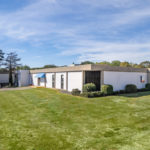Hinman, Kingscott design InterAct offices for flexibility, efficiency
KALAMAZOO – There is an upside to being able to lean across a cubicle wall to ask a colleague a question, rather than make a phone call or stroll down the street.
For InterAct of Michigan, a Kalamazoo-based nonprofit organization providing mental health and substance abuse treatment, a building at 610 South Burdick Street represents an opportunity to bring its staff under one energy-efficient roof. The agency has experienced significant growth since 2003, and with 100 employees spread out over three different offices in Kalamazoo – many in offices that were converted from other uses – the new facility will allow for better communication among staff members, said Claudia Wink-Basing, executive director of InterAct.
“We’re a nonprofit agency that’s been in business for 20 years, and we have expanded five different times, and each time we needed more space to work with,” Wink-Basing told MiBiz. “We hit a big expansion of services with a contract we bid out in 2003 and added a third building in 2004. It made it clear that we needed to find a way to be all in one site to improve operations. Even though we’re a few blocks away from one another, communication is an issue.”
InterAct had pursued many options as it looked to consolidate its offices and considered building an office of its own, but worked with The Hinman Company on a design that fit both organizations’ needs.
“We decided that ownership wasn’t at the top of the list. That distracts from our mission of providing mental health and substance abuse services. We explored a number of options…but nothing was big enough. We liked the centrally located space in downtown Kalamazoo, but there was nothing comparable in a 5-mile radius,” she said.
| FYI InterAct of Michigan 610 S. Burdick Street – Investment: $1.95 million – 24,000 square feet – Architect: Kingscott Associates – Project manager: The Hinman Company – Interior: Haworth interiors provided by Michigan Office Environments |
While Hinman is building the facility with InterAct in mind, the company wanted to ensure that the building could easily be renovated for a new tenant should circumstances change and the agency decides to change its lease agreement, said Stephanie Hinman, director of sustainability at the company. The elevator and mechanical equipment is centrally located so that if needed, the building could be split into four office units.
“We can turn it into offices relatively easily,” Hinman told MiBiz. “It is designed so that we wouldn’t have to relocate a lot of the mechanical equipment. We’re looking at the lifecycle of the building there.”
The new facility is a step up in terms of accessibility, a key concern as many of InterAct’s clients have limited mobility. Hinman is seeking LEED Silver accreditation for the facility, and was able to divert 76 percent of the demolition of the existing building from landfills. For a nonprofit organization, energy costs at the three sites were a significant portion of their expenses, said Wink-Basing.
“We didn’t pick LEED, we’re just blessed with it. We know the energy costs we’re paying are ridiculous. The buildings we’re in are not comfortable. All of our offices are in older facilities that had grown from one use to another and were pretty worn out. They were minimally barrier-free to not barrier-free at all,” she explained. “The basic utility costs in these buildings were pretty outrageous. The organization’s cost effectiveness became impacted by this.”
For architect Susan Einspahr, senior principal at Kingscott Associates, the goal was to create a building that maintained the styling of Hinman’s other properties through the use of glass and brick, while giving InterAct the flexibility of use in a space that houses offices, conference rooms and a pharmacy.
“This is a building with a lot of flexibility. (InterAct) is a large group and can fill the building. If there were to be changes and they decided to move, the building is set up with a central corridor and Hinman could have the option of moving in up to four tenants, and yet it still works nicely for InterAct’s needs,” Einspahr said. “It was important to them, being based in the city, that they wanted this new building to fit into a city texture, rather than suburban.”
In Wink-Basing’s mind, the new facility helps the organization fulfill its mission.
“Recovery for people is possible and this helps create an environment where it is possible.”
Story written by Nathan Peck – MiBiz
View this article in PDF format



